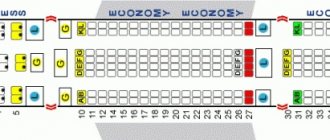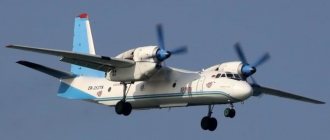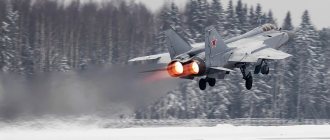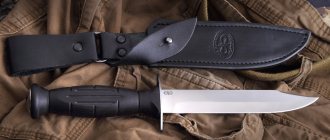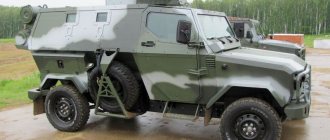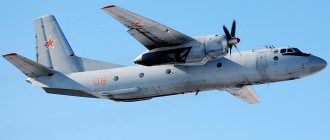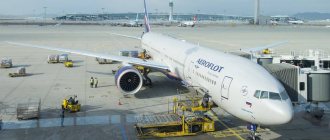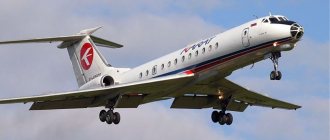The An-8, which according to NATO codification was called “Camp,” is a Soviet military transport aircraft developed by the Design Bureau named after. Antonov mid-50s. The purpose of the device was to transport various cargo, casualties, and to land airborne units along with equipment and weapons.
History of An-8
The development of the An-8 twin-engine aircraft began at the Design Bureau named after. Antonov in early 1954. A. Ya. Belolipetsky was appointed lead designer for the project. A number of specialists from other design bureaus were attracted to carry out the design work. In April 1954, they were joined by a large group of graduates from the Kharkov Aviation Institute. Much credit for the construction of the aircraft belongs to aircraft designer R.L. Bartini, who, in particular, is responsible for the design of the cargo compartment floor. The aircraft was developed simultaneously in two versions: passenger (product “N”) and military transport (product “P”).
Initially, the car was planned to be equipped with TV-2F engines, then it was planned to install TV-2T engines.
The development of the military transport version progressed faster than the passenger version, and soon the latter project was completely frozen. Instead, they began to develop the An-10 (product “U”). Work on the preliminary design of the transport aircraft was completed in July 1954. During the design, the designers solved many complex problems that were associated with the landing of cargo.
An-8 video
On 10/25/1954, 2 variants of the aircraft layout were presented to the mock-up commission: the first had TV-2T turboprop engines in the layout, the second - AL-7 turbojet engines. Then, assembly of the first prototype began at the Kiev Aviation Plant, which was completed at the end of 1955. The first takeoff was made by test pilots Ya.I. Vernikov and V.P. Vasin from Svyatoshinsky airfield (Kyiv).
The first public presentation of the experimental An-8 to the general public took place at the air parade in Tushino, along with another new Soviet aviation product, the Tu-104. State tests of the aircraft took place in the fall of 1956. They revealed insufficient indicators of static stability and controllability of the aircraft during crosswinds and landing, the occurrence of spontaneous self-oscillations in flight in a straight line, and insufficient engine thrust at high altitudes.
There was a proposal to use AI-20 instead of TV-2T engines, but their power reserve was clearly too small. At the suggestion of A.G. Ilyenko AI-20 was boosted and the power of each was increased to 5180 hp. In 1957, work was carried out to equip the prototype aircraft with AI-20D engines. Factory tests of the aircraft with this layout were completed on November 21. In parallel to this, at the ASTC named after. Antonov modified the design of the aircraft: the wingspan was increased by 0.8 m, anti-spin spoilers and the keel from the AN-10 were installed, and the fuselage was strengthened.
Serial production of the An-8 aircraft began at the end of 1957 at the Tashkent aviation plant. The first production car was released in August 1958. In the spring and summer of 1958, factory and state tests of the production aircraft were carried out. In the same year, it was adopted by the USSR military transport aviation. During the years of serial production (1958-1961), the Tashkent aircraft plant produced 151 aircraft. Was in the service of the BTA until 1970. Until this time, 80 cars were written off. And the remainder was redistributed between various government agencies, departments and ministries.
In 1997, Russian airlines had five An-70 aircraft in their fleet, which were operated in the Middle East. In 2004, ASTC named after. Antonova refused to take responsibility for the condition of those An-70 aircraft that were still in operation. But An-70 flights did not stop after that.
In accidents and disasters over the years of use, 27 An-8s were destroyed.
An-8 design
The An-8 is an all-metal cantilever high-wing aircraft. The fuselage is made as a semi-monocoque, has a rectangular cross-section with sharp corners in the middle part and a rounded upper part. The wing is two-spar, straight, trapezoidal. The wing is equipped with double-slotted flaps and two-section ailerons. The landing gear is tricycle and has a steerable nose strut that can be retracted into the fuselage. The low pressure of the landing gear pneumatics allowed the aircraft to take off and land on unpaved airfields.
The power plant includes two AI-20 turboprop engines, which were equipped with AV-68D feathering four-blade propellers. The left fairing of the chassis has a TG-16 turbo unit. The control cabin is sealed and partially armored. The cargo compartment is not sealed. The cargo hatch has dimensions of 2950 × 740 mm and is located in the rear fuselage. Loading of self-propelled equipment is carried out using the BL-52 winch. Group release of cargo can be carried out using the P95-T conveyor. Fuel is stored in 20 soft wing tanks, the total capacity of which is 13,080 liters.
Story
The world experience of combat operations (the Korean War of 1950-1953) proved the need to have an air cargo winged giant capable of taking off from unprepared field airfields, covering enormous distances, having a fantastic payload capacity, and, most importantly, operating and continuing the fight even when failure of one engine.[1]
Development of the An-8
began at ASTC. O.K. Antonov in January 1954 in accordance with Resolution of the USSR Council of Ministers No. 2922-1251 of December 11, 1953 and MAP Order No. 278 of December 23, 1953. A. Ya. Belolipetsky was appointed lead designer. To work on a project at ASTC. A number of specialists from other design bureaus were transferred to O.K. Antonov. In April 1954, a large graduating class of students from the Kharkov Aviation Institute was added to them. Aircraft designer R.L. Bartini also provided great assistance (in particular, he designed the floor of the cargo compartment). It was planned to develop the vehicle in two versions - military transport (product "P") and passenger (product "N").
Initially it was planned to install TV-2F engines on aircraft, later TV-2T. Work on the project for a military transport aircraft progressed faster than for a passenger aircraft, and soon the development of the latter project was completely suspended in favor of the future An-10 (product “U”). The preliminary design of the transport aircraft was ready in July 1954. When working on the project, the designers had to solve a number of complex problems related to the landing of cargo. On October 25, 1954, the customer’s mock-up commission was presented with a mock-up with 2 power plant options: with a TV-2T turboprop engine and an AL-7 turbojet engine. Then the production of the first prototype began at the Kiev Aviation Plant, which was completed in December 1955. The An-8 made its first flight on February 11, 1956 under the control of test pilots Ya. I. Vernikov (commander) and V. P. Vasin (co-pilot) from the Svyatoshino airfield. The first public demonstration of the aircraft took place on August 18, 1956, the experienced An-8 took part in an air parade over Tushino together with another new Soviet aircraft, the Tu-104. From October 2 to November 27, state tests of the aircraft took place. The tests revealed insufficient static stability and controllability of the aircraft during landing in crosswinds, spontaneous self-oscillations in straight flight, and poor engine performance at altitudes above 6000 m.
Instead of the TV-2T, it was proposed to install AI-20 engines, but their power was clearly not enough. However, A.G. Ivchenko proposed boosting the AI-20, bringing its power to 5180 hp. With. In July-October 1957, work was carried out to install AI-20D engines on the prototype. Factory testing was completed on November 21. In parallel, at the ASTC named after. O.K. Antonov, the design of the aircraft was modified: the wingspan was increased by 0.8 m, the keel from the An-10 and anti-spin spoilers were installed, the fuselage was strengthened. In the same year, the Tashkent Aviation Plant began serial production of the aircraft under the designation An-8
. To ensure production efficiency, a branch of the ASTC named after. O.K. Antonov (order of the State Committee for Transport and Communications of the Russian Federation dated July 29, 1959). The first production An-8 left the assembly shop in August 1958. On June 20, 1959, factory tests began, and on August 7, state tests of the serial An-8 began. The tests ended on October 30 with a positive result. In the same year, the aircraft was accepted into service with the Military Air Forces. But fine-tuning continued even after that.
The An-8 was mass-produced at the Tashkent Aviation Plant in 1958-1961. A total of 151 aircraft were produced. Since 1959, the An-8 aircraft began to enter service with military transport aviation, where it was operated until 1970. By this time, 80 vehicles had been written off, and the rest were transferred to units of other branches of the military and various ministries. In 1997, there were 5 aircraft in operation by Russian airlines that carry out commercial transportation in the Middle East, while the use of the An-8 over the Russian Federation was already prohibited. In 2004, the Ukrainian ASTC named after. O.K. Antonova refused any responsibility for the condition of the aircraft that were still in operation, effectively ceasing their legal use. However, An-8 made commercial flights in Africa even after that: in January 2005, an aircraft of this type crashed in the Democratic Republic of Congo. In total, over the years of operation, 27 An-8 aircraft were lost.[2]
Non-core products
At various times, ANTK Antonov was also involved in the development of non-core products. The most significant work was in the field of ground transport. The airline's designers implemented their ideas in the construction of a series of sports cars based on the GAZ M-21 Volga and Moskvich-407 models. The new cars acquired the name “Kyiv-Sport”. The car was equipped with a space frame, the material for which was thin-walled steel pipes. The car's body panels were made from aircraft-grade duralumin. A total of 3 Kyiv-Sport cars were built in different configurations. One of the cars, equipped with a Gas-21 engine, has been preserved to this day.
In 1980, having extensive knowledge in the field of aerodynamics, the company’s specialists developed carbon fiber bobsleigh bobs, which were used by athletes of the USSR and Ukraine at the Winter Olympics in 1984 and 1994.
Also, individual departments took part in the development of advanced carbon fiber bicycle frames. It was on bicycles with frames from ASTC that Ukrainian athletes took gold at the World Championships in 1996.
Also in the early 1990s, the company carried out developments to create urban transport. Technical documentation for the K12 “Kyiv” trolleybus was transferred from ASTC, which began to be mass-produced there until 2002.
In a joint project of the Antonov State Enterprise and the Lugansk Diesel Locomotive Plant, an experimental version of a low-floor tram using an LT-10A aluminum body was built, but the high cost did not allow serial production of this model to begin.
In 2014, ANTK Antonov built an armored vehicle, which was sent to the ATO zone.
Aircraft safety
The development of the An-148 was carried out taking into account modern requirements for safety and reliability. All international standards were met, which made the aircraft one of the most successful Ukrainian developments since the collapse of the USSR.
Particular attention is paid to automated control and navigation systems. They allow you to control the aircraft in difficult weather conditions and on busy routes, timely detect security threats and land the aircraft in poor visibility conditions
Despite the high level of safety, incidents related to on-board electronics are also known. In 2010, the failure of one of the control channels led to a dive. In manual mode, the pilots managed to level the plane and land.
In 2012, an accident occurred due to the separation of a landing gear wheel during takeoff. In 2020, two incidents occurred due to engine problems. The worst accident was the crash on February 11, 2020, which killed 71 people. On March 20 of the same year, Rostransnadzor ordered Saratov Airlines to stop operating the An-148.
